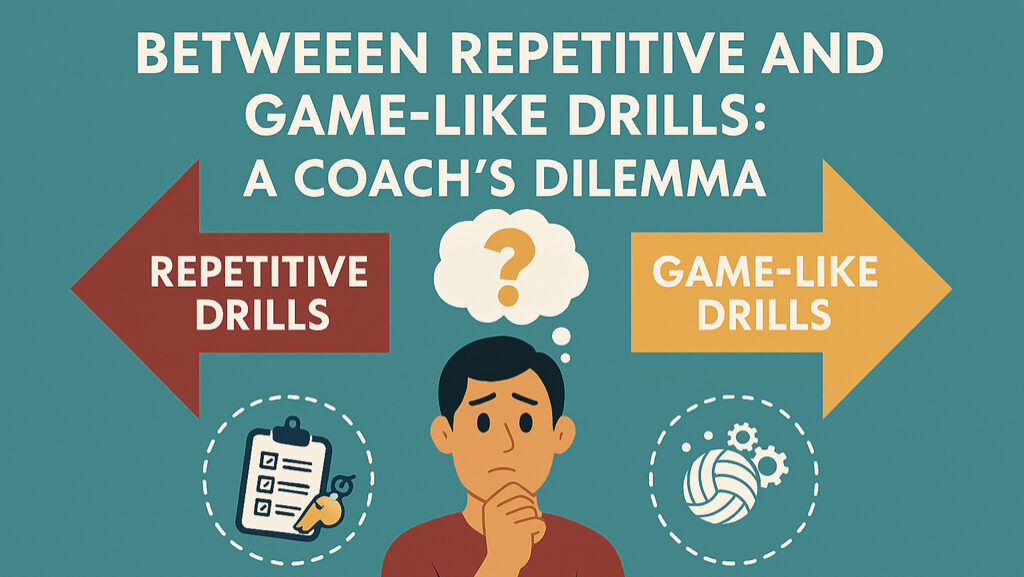I must first acknowledge that I’m writing this article amid an ongoing internal struggle. I find myself constantly wavering between “repetitive drills” and “game-like drills.”
Repetitive Drills vs Game-Like Drills
I’m involved in coaching at the elementary school level. Within my training planning and implementation, I constantly face a fundamental dilemma.
This dilemma centers on how to effectively incorporate both “repetitive drills” and “game-like drills” into training programs.
This struggle didn’t begin recently. I’ve been experimenting and contemplating how to integrate these approaches into practice programs for years.
Sometimes it works well; sometimes it doesn’t.
Just when I think I’ve found the right answer, I’m quickly pushed back to the starting point. Through these recurring cycles, I just completed my first year with the current team yesterday.
I consider this dilemma a kind of eternal theme. At this milestone, I want to reflect once more and articulate this ongoing struggle.
First, let me define each type of drill in my own words.
Expected Outcomes: Repetitive Drills
In my understanding, repetitive drills refer to exercises where specific movements are repeated under consistent environmental conditions to acquire desired motor skills.
While “consistent environment” and “same movements” naturally have some variation, I believe the essence of repetitive drills is that only “expected” outcomes occur for the participants.
Unexpected Challenges: Game-Like Drills
Game-like drills, in my view, are exercises conducted in environments that simulate actual match conditions, where each player makes decisions and executes plays independently.
These drills consistently maintain “game” as a central concept, and like actual games, they involve constant uncertainty – meaning “unexpected” situations continuously arise.
It’s important to note the distinction implied by “like” – these are not “game drills” (scrimmages are not game-like drills). The consciousness inherent in these drills involves intentionally creating game-like situations through situational settings and play conditions.
The “Chicken or Egg” Problem
The relationship between repetitive drills and game-like drills resembles the classic “chicken or egg” dilemma.
For explanation of this problem, I’ll borrow from Wikipedia:
“The chicken or egg causality dilemma is essentially the question of ‘which came first, the chicken or the egg?’ For ancient philosophers, this question led to broader questions about how life and the universe began. In scholarly contexts, referring to ‘chicken or egg’ points to the futility of trying to identify the origin point of mutually cyclical causes and effects. This perspective reveals the most fundamental nature of this question.”
As the quote indicates regarding scholarly contexts – pointing to “the futility of trying to identify the origin point of mutually cyclical causes and effects” – the question of which comes first (or which is more important?) between repetitive drills and game-like drills is ultimately futile.
The conclusion is that both are important.
Moving Between Repetitive and Game-Like Drills
Let me restate the dilemma I outlined earlier:
How should we incorporate both repetitive drills and game-like drills into training programs?
My current best attempt at a summary (which may not actually summarize anything) is as follows:
The key lies in continuously discovering the optimal balance suited to each team and player’s situation through constant movement between repetitive drills and game-like drills.
This “optimal balance” will differ significantly between youth development teams with many beginners and select teams composed of mature players.
The optimal balance depends on and changes with the team and players. Even with the same team and players, it continuously evolves based on timing and circumstances.
The coaching dilemmas discussed in this article will persist until I stop being a coach. Conversely, when this internal struggle disappears, I believe it will be time to stop coaching.
While contemplating questions without answers is challenging, it provides a profound sense of being alive.
Practical Applications for Youth Development
This philosophical tension between drill types represents a fundamental aspect of effective youth volleyball coaching. The continuous search for balance reflects the dynamic nature of athlete development.
Key Considerations for Coaches:
Assessment-Based Programming: Regularly evaluate team skill levels and individual player needs to adjust the drill balance appropriately.
Developmental Progression: Understand that the optimal ratio of repetitive to game-like drills evolves as players mature both technically and cognitively.
Contextual Flexibility: Recognize that factors such as competition schedule, season phase, and team dynamics all influence the ideal training approach.
This ongoing tension between structured skill development and chaotic game preparation embodies the art of coaching – finding harmony between opposing forces to maximize player growth.
Keywords: repetitive drills vs game-like drills, volleyball training methodology, youth coaching philosophy, drill balance optimization, volleyball skill development, coaching decision-making, training program design, volleyball pedagogy


